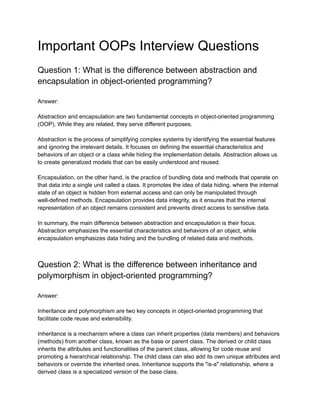
OOps Interview questions.pdf
- 1. Important OOPs Interview Questions Question 1: What is the difference between abstraction and encapsulation in object-oriented programming? Answer: Abstraction and encapsulation are two fundamental concepts in object-oriented programming (OOP). While they are related, they serve different purposes. Abstraction is the process of simplifying complex systems by identifying the essential features and ignoring the irrelevant details. It focuses on defining the essential characteristics and behaviors of an object or a class while hiding the implementation details. Abstraction allows us to create generalized models that can be easily understood and reused. Encapsulation, on the other hand, is the practice of bundling data and methods that operate on that data into a single unit called a class. It promotes the idea of data hiding, where the internal state of an object is hidden from external access and can only be manipulated through well-defined methods. Encapsulation provides data integrity, as it ensures that the internal representation of an object remains consistent and prevents direct access to sensitive data. In summary, the main difference between abstraction and encapsulation is their focus. Abstraction emphasizes the essential characteristics and behaviors of an object, while encapsulation emphasizes data hiding and the bundling of related data and methods. Question 2: What is the difference between inheritance and polymorphism in object-oriented programming? Answer: Inheritance and polymorphism are two key concepts in object-oriented programming that facilitate code reuse and extensibility. Inheritance is a mechanism where a class can inherit properties (data members) and behaviors (methods) from another class, known as the base or parent class. The derived or child class inherits the attributes and functionalities of the parent class, allowing for code reuse and promoting a hierarchical relationship. The child class can also add its own unique attributes and behaviors or override the inherited ones. Inheritance supports the "is-a" relationship, where a derived class is a specialized version of the base class.
- 2. Polymorphism, on the other hand, refers to the ability of an object to take on different forms or behaviors. It allows objects of different classes that are derived from a common base class to be treated as objects of the base class. Polymorphism enables dynamic method binding, where the appropriate method implementation is determined at runtime based on the actual type of the object. This flexibility allows for code extensibility, as new derived classes can be created without modifying existing code that depends on the base class. In summary, inheritance facilitates code reuse and promotes a hierarchical relationship between classes, allowing derived classes to inherit attributes and behaviors from a base class. Polymorphism enables objects of different derived classes to be treated as objects of the base class, allowing for dynamic method binding and code extensibility. Question 3: What is the difference between method overloading and method overriding in object-oriented programming? Answer: Method overloading and method overriding are two ways to achieve polymorphism in object-oriented programming, but they have different characteristics and purposes. Method overloading is a concept where multiple methods with the same name but different parameter lists exist within a class. These methods can have different types or different numbers of parameters. The compiler determines which method to invoke based on the arguments passed during the method call. Overloading allows a class to provide multiple ways of performing a similar operation, enhancing code readability and flexibility. Method overriding, on the other hand, occurs when a derived class provides its own implementation of a method that is already defined in its base class. The method in the derived class must have the same name, return type, and parameter list as the method in the base class. The overridden method in the derived class is used when calling the method on objects of the derived class. Method overriding allows for the modification or extension of the behavior defined in the base class, enabling specialization and customization. In summary, method overloading involves having multiple methods with the same name but different parameters within a single class, allowing for different ways of performing similar operations. Method overriding occurs when a derived class provides its own implementation of a method defined in the base class, enabling customization and specialization of behavior. See more coding interview questions.